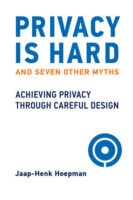An expert on computer privacy and security shows how we can build privacy into the design of systems from the start.

“Het gebeurt niet vaak dat een boek over privacy een frisse kijk geeft en nieuwe dingen om over na te denken. Hoepman’s invalshoek als informatiewetenschapper heeft dat wel voor elkaar gekregen. Op een heldere en beknopte manier legt hij zaken uit als ‘polymorphic encryption’, ‘statistical disclosure control’, ‘differential privacy’, ‘revocable privacy’, ‘attribute based credentials’, ‘blind signatures’, en nog veel meer. Hij gebruikt slimme praktijkvoorbeelden om aan te tonen dat het niet zo moeilijk is om de privacy te verbeteren van veel van de systemen die we dagelijks gebruiken (ik vond zijn voorbeeld van de nummerplaatherkenning in een parkeergarage prachtig). Het boek eindigt met een aantal nuttige strategieën om privacy by design te implementeren. Ik zou willen dat alle mensen die werken aan technologische systemen, in welke vorm dan ook, dit boek zouden lezen.” — Hans De Zwart
We are tethered to our devices all day, every day, leaving data trails of our searches, posts, clicks, and communications. Meanwhile, governments and businesses collect our data and use it to monitor us without our knowledge. So we have resigned ourselves to the belief that privacy is hard—choosing to believe that websites do not share our information, for example, and declaring that we have nothing to hide anyway. In this informative and illuminating book, a computer privacy and security expert argues that privacy is not that hard if we build it into the design of systems from the start.
Along the way, Jaap-Henk Hoepman debunks eight persistent myths surrounding computer privacy. The website that claims it doesn’t collect personal data, for example; Hoepman explains that most data is personal, capturing location, preferences, and other information. You don’t have anything to hide? There’s nothing wrong with wanting to keep personal information—even if it’s not incriminating or embarrassing—private. Hoepman shows that just as technology can be used to invade our privacy, it can be used to protect it, when we apply privacy by design. Hoepman suggests technical fixes, discussing pseudonyms, leaky design, encryption, metadata, and the benefits of keeping your data local (on your own device only), and outlines privacy design strategies that system designers can apply now.
Jaap-Henk Hoepman: Privacy Is Hard and Seven Other Myths. Achieving Privacy through Careful Design — MIT Press, 2021, 280 p., isbn 9780262045827

